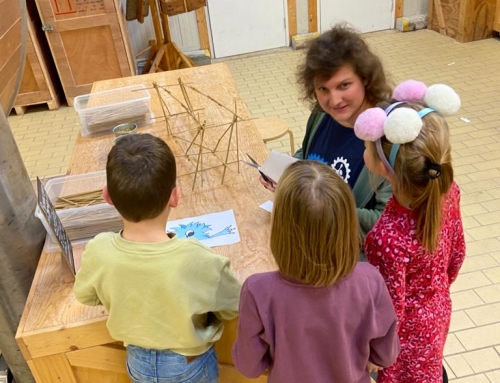For my graduation project, I worked together with the De Uitvindfabriek, an organisation located in Breda. De Uitvindfabriek is an experience centre aimed at the target group of children and young people, in the age of 4-16 years. De Uitvindfabriek organizes and facilitates programs and events that contribute to talent development and raising awareness for technology, design and innovation among children and young people.
De Uitvindfabriek
De Uitvindfabriek is a place where learning takes place through direct, fun and engaging experiences, so that children can become acquainted with their aptitude for technology. At a young age, children have to make choices that partly determine their future career opportunities. In order for this choice to be made responsible, it is necessary for the kids to become acquainted with their talents, including their aptitude for technology.
According to Van Tuijl et al. (2016), children develop an awareness of attitudes and images towards certain working environments at an early age. STEM related fields (science, technology, engineering, and mathematics) are not given proper attention, narrowing their perception of employment options, and impacting their future career choices. Modern workplaces are constantly and rapidly evolving, and knowledge quickly becomes obsolete. The rapid nature of technological evolution in the workplace means that children and young people need to learn skills appropriate to their time and creatively engage with the possibilities that new technologies offer. Developing creativity is indispensable to maintain progress and keep up with the needs of an evolving workplace.
At De Uitvindfabriek, children discover their technical and creative talent and are enthused to design, create and present inventions. Moreover, they aim to show how fun and useful the application and the design of technology can be. In addition, De Uitvindfabriek contributes to the realization that technology and innovation form important parts of society in the Netherlands, and in the region West Brabant in particular. De Uitvindfabriek therefore emphasizes the link between ‘technical’ and ‘creative’ sectors and development of creative talent. Developing creativity is a recognized 21st century skills and is indispensable for the professions of the future (“Werken aan je 21st century skills”, 2022).
The Challenge
De Uitvindfabriek is currently developing several initiatives. As of this time of writing, a summer school is being developed, a collaboration with Warchild is in the works, and an Urban Living Lab Junior is being created. All of these activities are planned to contribute to the overall goal of De Uitvindfabriek of contributing to the development of 21st century skills among children.
However, it is unclear how much of an impact De Uitvindfabriek actually has on this goal at large. Prior research on the impact that De Uitvindfabriek makes within the organisation has been scarce. De Uitvindfabriek is looking to change this and aims to find out if they are making an impact with their approach. This knowledge can then be applied within their concept and strategy, along with the many initiatives that are currently being developed.
As mentioned in my first blog, I want to explore what I can do as a social innovator in order to address the changing technological landscape, in order to create meaningful desired impact for the youth of today. I want to help to prepare the future generation so that they have the skills necessary to partake in the work environment of the future. With that in mind, I aim to clarify how the following problem statement will be addressed:
How might De Uitvindfabriek ensure that they fulfil their purpose?
The Approach
My approach in this research will be to apply the Design Thinking model (Dam, 2022) which can be seen in figure 1 below. Design thinking can be implemented using any number of different quantitative or qualitative methodologies and methods. Many academics have suggested that qualitative research is more appropriate when conducting an open-ended and complex study, particularly one with practical implications (Clarke et al., 2015). Understanding the goal and impact of De Uitvindfabriek using a Design Thinking model was considered to be an open-ended and complex study. A qualitative approach was therefore chosen for this research. However, this does not rule out the possibility of a quantitative approach being taken in the future should there be time and a desire to expand on this research project. Using the four phases of the model, I will address the problem statement. I will go through each of these stages in order.

Figure 1: Design Thinking model (Dam, 2022)
I am excited to find out how I can help De Uitvindfabriek fulfil their purpose. De Uitvindfabriek is an organisation that dreams of a bright future. In a world that is changing every day due to technological developments, they want children to grow up with all the toolkits they need to thrive in an unknown future environment. The children of today will be the leaders of tomorrow, and by nurturing and helping them discover their talent, De Uitvindfabriek aims to contribute to the society of the future. With this project, I hope to develop myself in creating meaningful impact in the children to help create a future where people can take advantage of technology advancements and handle the challenges that come with them. In my next blog, I will talk about the challenges I faced as a social innovator when working with children.
References
Het Nederlandse Zorgstelsel. Ministerie van Volksgezondheid, Welzijn en Sport. (n.d.). https://na.eventscloud.com/file_uploads/d264531c5bd30ce1e9d6d4a88ff96179_Het_Nederlandse_Zorgstelsel.pdf.
Scp: vijf jaar na nieuwe wet is zorg voor kwetsbare mensen en kinderen nog niet op orde. (2020, November 16). RTLnieuws. https://www.rtlnieuws.nl/nieuws/nederland/artikel/5196890/scp-wmo-decentralisatie-zorg-wet-maatschappelijke-ondersteuning.





